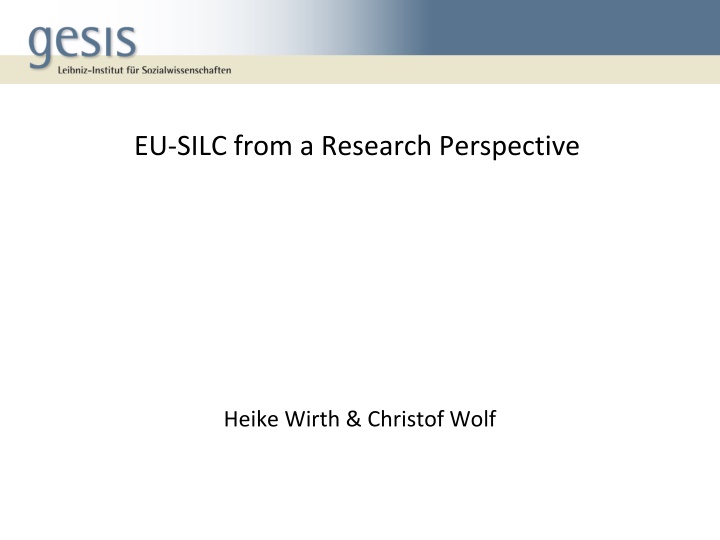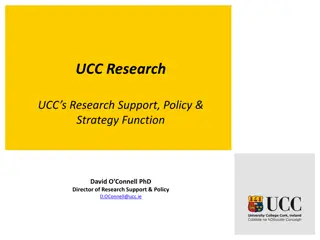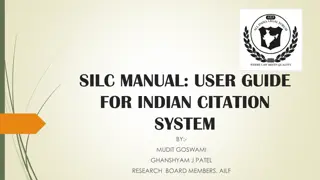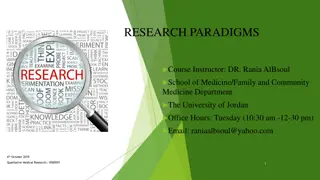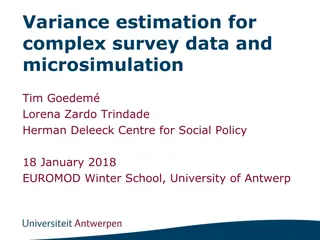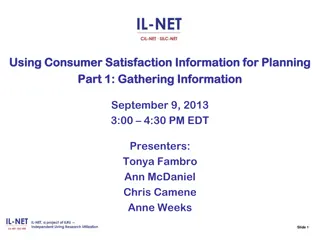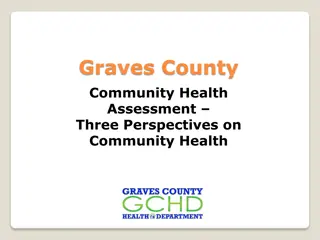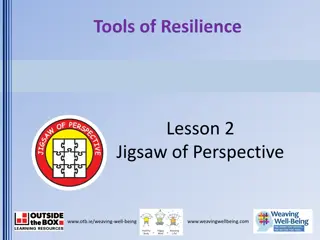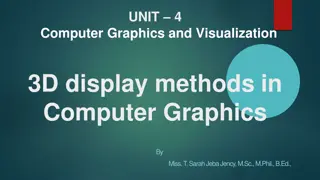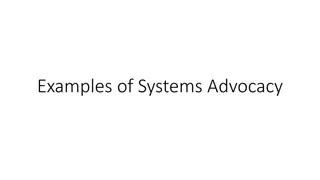EU-SILC from a Research Perspective
EU-SILC (European Union Statistics on Income and Living Conditions) is a crucial data source for social reporting and policy evaluation in Europe. This research perspective delves into the strengths, flexibility, comparability, and importance of EU-SILC data for longitudinal analysis and cross-national assessment. Topics covered include data comparability issues, opportunities for analysis, and the flexibility of implementation within a common framework, ensuring harmonized output. Understanding the potential sources of non-comparability is key to utilizing EU-SILC effectively for informed decision-making.
Download Presentation

Please find below an Image/Link to download the presentation.
The content on the website is provided AS IS for your information and personal use only. It may not be sold, licensed, or shared on other websites without obtaining consent from the author.If you encounter any issues during the download, it is possible that the publisher has removed the file from their server.
You are allowed to download the files provided on this website for personal or commercial use, subject to the condition that they are used lawfully. All files are the property of their respective owners.
The content on the website is provided AS IS for your information and personal use only. It may not be sold, licensed, or shared on other websites without obtaining consent from the author.
E N D
Presentation Transcript
EU-SILC from a Research Perspective Heike Wirth & Christof Wolf
Topics covered Strengths of EU-SILC Flexible implementation of EU-SILC Selected issues regarding data comparability Opportunities for longitudinal analysis with EU-SILC 2
Strengths of EU-SILC Coverage of countries Coverage of topics (Private) Household survey Cross-sectional and longitudinal data Good and improving data documentation Access for research purposes free of charge (but more demanding under new regulation) 3
Flexible implementation of EU-SILC EU-SILC is based on a common framework guidelines: concepts, definitions, classifications, procedures Target variables, i.e. ex ante harmonization Within this framework high flexibility regarding data generation Accommodates the national conditions and needs (+) Potential to limit cross-national comparability ( ) While the input side might be diverse, the output side is harmonized (standardized microdata set) i.e. problems of data comparability are not directly visible 5
Flexible implementation of EU-SILC Some potential sources of non-comparability (1) Different sampling strategies (2) Different survey designs (3) Different modes of data collection (4) Different field work periods and procedures (5) Different national questionnaires (6) Different reference periods (7) Different nonresponse rates (8) Different attrition rates 6
Why is comparability so important? EU-SILC is the central data source for social reporting in Europe Social indicators based on EU-SILC are used to assess countries places in relation to each other to learn from others best practices to evaluate policy measures 8
Selected issues regarding data comparability 1. Different survey designs and response rates 2. Different modes of data collection 3. Ex-ante output harmonization: Wording of questions 9
Comparability 1: Survey design and response rates Survey design Rotational panel: variations across countries in the number of rotations. Most countries 4, but 8 in NO, 9 in FR and full panel in LU (in the future possibly 6 or more waves) Response rates and attrition vary throughout Europe 10
SILC response rates 2007 (only new rotational group) 100 80 60 40 20 0 PL PT BE BG AT IT IS NL SI FI SK CY FR SE NO CZ LV MT ES EE EL DK UK HU DE RO Source: Eurostat: Proposal for revising the design of EU-SILC longitudinal component. Item 4; 5thMeeting of the Task-Force on the revision of the EU-SILC legal basis. 11
EU-SILC retention rates (a) households, (b) individuals re-interviewed the following year, in % 100 95 90 85 80 75 70 PL BG PT BE AT SI NL IE IT SE FI NO IC LU SP LT CZ CY SK EL FR LV EE DK HU RO UK % of eligible households in which at least one member was interviewed the next year % of eligible individuals in the sample who were interviewed the next year Source: Iacovou et al (2012) from EU-SILC longitudinal files, release 2008-4, unweighted 12
Comparability 2: Different modes of data collection Sources of EU-SILC data could be: survey(s) register(s) combination of survey(s) & register(s) Data could come from one source or two sources Issue of concern: Substantial findings of EU-SILC such as indicators used in social reporting may differ due to the diversity in the data collection across countries 13
Different modes of data collection (2010) Information/ Interview completed from Both: Survey & Register Full Record Imputation Survey Register 73.1% 3.4% 22.8% 0.7% Register countries Survey countries DK, FI, SE, NL, IS, LV, SI, IE BE, BG, CY, CZ, DE, GR, ES, EE, FR, HU, IT,LT, LU, MT; AT, PL, PT, RO, SK, UK 14
Different modes of data collection Measures in surveys and registers may be based on different concepts, e.g. Earnings information in registers tax-based (non taxed earnings?) different points in time when income and tax are collected (self-employed, temporary workers) Employment, Unemployment evidence that information on unemployment in survey and registers differ in a significant way at the individual level survey: e.g. memory errors regarding employment situation in the past Consistency problems if combining information from different sources? 16
Different modes of data collection Mixed modes of data collection in surveys Personal interview (respondent) CATI (Computer Assisted Telefon Interview) CAPI (Computer Assisted Personal Interview) PAPI (Paper and Pencil Personal Interview) self-administered (respondent completes the questionnaire him/herself) Proxy-interview (respondent has someone else answer the questions for him/her) Type of interview might affect the response and thus reduce the comparability between countries and for countries with sequential mixed mode between waves 17
Different modes of data collection (2010) SURVEY COUNTRIES REGISTER COUNTRIES Register & Interviews 22.8% Interview 73.1% Face to Face Face to Face CAPI 0.4% PAPI 11.7% CAPI 29.1% PAPI 42.3% CATI CATI 65.6% 3.9% Self- Self- administered administered 5.5% 0.4% Proxy Interview Proxy Interview 18.3% 22.0% 18
Proxy interview by country register countries % of proxy interviews Country Iceland proxy interview 0.0 Nederland 1.2 Sverige 2.1 Ireland 23.7 Latvia 23.7 Norway 23.8 Slovenia 24.6 As a rule only 1 person in hh is interviewed, who answers also for all other hh members Suomi 42.7 Danmark 48.6 Datasource: UDB_c10R_ver 2010-2 from 01-08-12, own computation 19
Proxy interviews by country survey countries % of proxy interviews Slovak Republic Ellada Belgique United Kingdom Oesterreich Romania Lithuania Deutschland Italia Poland Datasource: UDB_c10R_ver 2010-2 from 01-08-12, own computation 4.3 8.0 8.6 10.7 13.7 15.3 15.6 18.8 19.0 19.2 Czech Republic Hungary Luxembourg Bulgaria Portugal Espana Cyprus Estonia France Malta 19.3 19.8 20.1 20.3 20.5 21.9 23.0 24.3 27.6 28.9 20
Flexibility in modes of data collection Quality of proxy interviews might depend on the reason of the proxy interview 1. a respondent is not accessible or willing to give an interview proxy interview are cofounded with other characteristics like age or sex 2. producers take proxy interviews as a mean to lower costs data producers might make efforts for a random selection of proxy respondents 21
Comparability 3 Different questionnaires SILC is ex ante harmonized, i.e. variables which are delivered by the NSIs to Eurostat are defined in regulations & guidelines (=> standard EU-SILC definition) But there is no common SILC questionnaire questionnaire design varies (e.g. order of questions) wording of questions varies (e.g. How often do you usually .. or 'How often during a usual year do you ?) 22
Research example Research example Gash (2011): Methodological issues in comparative research. European Workshop to Introduce the EU-SILC and EU-LFS Manchester Research interest How does unemployment affect social engagement? EU-SILC Module (2006) on Social Participation Frequency of contacts/getting together with friends &relatives Ability to ask relatives, friends, neighbours for help Participation in formal and informal activities Participation in cultural/sport events 23
Research example Main findings: Broad agreement in the questionnaire wording across countries, but 1. Some countries provide examples of social participation others not 2. Some countries mention reference periods others not 3. Some countries prompt that respondents should exclude people they live with others not Might have an effect on the reported frequencies of contacts 24
Source: Gash, Vanessa (2011): METHODOLOGICAL ISSUES in COMPARATIVE RESEARCH 25
Comparability 3 - Output harmonization When Eurostat knows about problems arising from different wording or other deviations in the questoinnaire it reports this Most national questionnaires are available Check documentation!!! 26
Opportunities for Longitudinal Analysis with EU-SILC 27
Opportunities for Longitudinal Analysis Main topics studied with SILC (Eiffe & Till 2013) Income studies Poverty studies Labour market studies Limitations arise because SILC is a short-term panel, i.e. a maximum of 3 transitions 28
Income studies Income distribution What are the consequences of income gains and losses on income inequality and poverty levels? How do regional economic and labour market structures as well as national institutions contribute to changes of income level and income distribution? Income dynamics How much does income mobility vary across European countries? See: Franz F. Eiffe and Matthias Till. 2013. The Longitudinal Component of EU SILC Still Underused? NetSILC2: Working Paper 1/2013. 29
Income studies Impact of socio-economic events on income Impact of having a disabled person in a household Changes in women s contribution in Italian families Effect of partnership breakdown on individual income See: Franz F. Eiffe and Matthias Till. 2013. The Longitudinal Component of EU SILC Still Underused? NetSILC2: Working Paper 1/2013. 30
Poverty studies How long do individuals or households remain in poor living conditions? How often do Europeans experience poverty over their life span (or at least over four years)? What are the profiles of households who remain in poverty for longer periods? What are the events/determinants that trigger poverty transitions? See: Franz F. Eiffe and Matthias Till. 2013. The Longitudinal Component of EU SILC Still Underused? NetSILC2: Working Paper 1/2013. 31
Labour market studies What patterns of occupational mobility can be observed in Europe? How difficult is it to leave unemployment? How do labour market dynamics differ across countries? Can difference between countries be explained by different institutions, e.g. welfare state arrangements? See: Franz F. Eiffe and Matthias Till. 2013. The Longitudinal Component of EU SILC Still Underused? NetSILC2: Working Paper 1/2013. 32
Possible problems of SILC longitudinal Different attrition rates could be a problem If there is a correlation between attrition and income or others variables this would be a problem However, income bias related to attrition seems to be low 33
Household participation in SILC by Income Quintiles in previous year 2.0 % Non-Response / % Response 1.5 1.0 0.5 0.0 1 2 3 4 5 Income Quintiles Source: Eurostat: Proposal for revising the design of EU-SILC longitudinal component. Item 4; 5thMeeting of the Task-Force on the revision of the EU-SILC legal basis. 34
